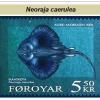پستها: 15
زبان: English
sudanglo (نمایش مشخصات) 7 نوامبر 2013، 10:52:08
Ŭ never starts words.Ŭaŭ! Tion mi ne sciis.
Bruso (نمایش مشخصات) 7 نوامبر 2013، 11:51:37
sudanglo:Ŭhat ŭould ŭe ŭrite ŭithout ŭ's?Ŭ never starts words.Ŭaŭ! Tion mi ne sciis.
Nile (نمایش مشخصات) 7 نوامبر 2013، 13:32:33
Just as I has the semivowel J, U has Ux and V.
V appearing at onsets and Ux in codas. They're almost allophones.
bartlett22183 (نمایش مشخصات) 7 نوامبر 2013، 19:39:53
Bemused:1) The supersigned letters which are used in no other orthography on earth. 2) The -n morpheme. 3) Adjectival agreement.bartlett22183:Long, long ago in a galaxy far, far awayInteresting, so what are the other two big objections?I was one of those people who strenuously subscribe to the "Big Three" objections to Esperanto, one of which is the supersigned letters.
Are those objections unique to speakers of English, or are they shared with speakers of other languages?
At one time I subscribed to all three of these objections. As I mentioned above, once I decided to take fifteen minutes of effort with a modern computer system, objection 1) became so trivial as no longer to be worth seriously considering. 3) might still have minor consideration for me, but it is not worth overwhelming a century and a quarter of fluent usage and is not that major a matter. 2) I have come to consider has some practical value in all the Esperanto texts I have read in recent years, and again, I do not consider it worth monkeying with.
Consequently, I personally no longer hold to the "Big Three" objections.
Ondo (نمایش مشخصات) 7 نوامبر 2013، 19:58:35
Nile:Ux actually doesn't even occur in onsets.You are getting very very close to the truth, Nile.
Just as I has the semivowel J, U has Ux and V.
V appearing at onsets and Ux in codas. They're almost allophones.




